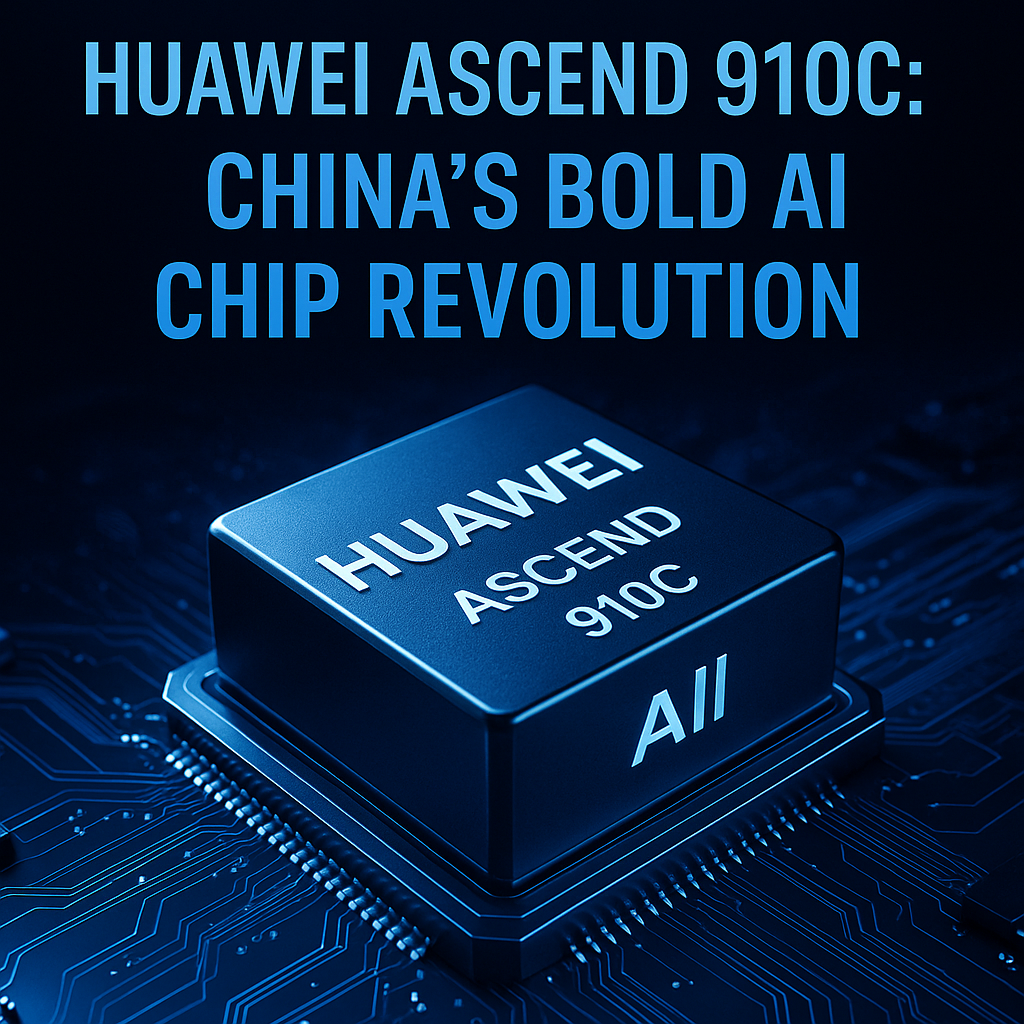Huawei Ascend 910C AI Chip: China’s Bold Move to Replace Nvidia Amid U.S. Export Ban
Introduction
In a game-changing move in the global tech arena, Huawei has unveiled its Ascend 910C AI chip, a strategic answer to the widening gap caused by the U.S. ban on Nvidia exports to China. The newly launched chip marks a significant milestone in China’s pursuit of technological self-reliance, as escalating U.S. restrictions on AI hardware continue to pressure Chinese innovation.
As the U.S. government tightens its export policies—now requiring licenses even for Nvidia’s H20 chips—Chinese tech firms are racing to build homegrown solutions. Huawei’s Ascend 910C AI chip is a remarkable achievement in this race, showcasing performance that rivals some of Nvidia’s best offerings. With years of AI and tech journalism expertise, we dive deep into what the Ascend 910C means for the future of AI development and geopolitical tech dynamics.
What is the Huawei Ascend 910C AI Chip?
The Huawei Ascend 910C AI chip is Huawei’s latest artificial intelligence processor, designed to serve as a domestic alternative to Nvidia’s high-performance AI chips like the H100. The 910C is an upgraded evolution of Huawei’s previous 910B model, featuring integrated architecture that combines the capabilities of two 910B units into a single powerful machine.
Manufactured using a 7nm process technology by China’s Semiconductor Manufacturing International Corporation (SMIC), the Ascend 910C is tailored to handle complex AI reference tasks. While it delivers approximately 60% to 80% of the Nvidia H100’s capabilities, it offers a critical advantage to Chinese firms needing reliable AI processing without relying on foreign imports.
According to Reuters and Financial Times, the chip also powers Huawei’s new CloudMatrix 384 AI cluster, a system capable of delivering 300 petaflops of compute performance — surpassing Nvidia’s GB200 NVL72 cluster, although with higher energy consumption.
Benefits/Importance of the Huawei Ascend 910C AI Chip
- Boosts China’s Technological Self-Reliance: Reduces dependency on U.S. AI hardware.
- Maintains AI Development Momentum: Provides Chinese firms with a powerful, accessible AI processor amid export restrictions.
- Economic Impact: Supports China’s semiconductor industry and counters financial setbacks caused by U.S. sanctions.
- Compatibility: Works seamlessly with major AI frameworks like TensorFlow, PyTorch, and MindSpore.
- Geopolitical Influence: Demonstrates China’s resilience and strategic focus on AI leadership.
Example: Early adopters in China are already integrating the 910C into research labs, cloud computing systems, and national AI projects to maintain competitiveness globally.
How to Utilize the Huawei Ascend 910C AI Chip
Step 1: Select Compatible AI Frameworks
- Use TensorFlow, PyTorch, or Huawei’s native MindSpore for optimized performance.
Step 2: Deploy Within Supported AI Clusters
- Integrate with Huawei’s CloudMatrix 384 AI cluster for large-scale machine learning projects.
Step 3: Optimize Model Training
- Tailor hyperparameters and optimization algorithms for Ascend architecture to maximize computational efficiency.
Step 4: Monitor Energy Consumption
- Balance performance with power consumption, especially in large deployments.
Best Practices & Expert Tips for Huawei Ascend 910C AI Chip
- Prioritize Framework Compatibility: Choose frameworks and libraries officially optimized for Ascend architecture.
- Focus on Energy Efficiency: Implement energy-saving protocols during long training sessions.
- Leverage Domestic Support Networks: Engage with Huawei’s developer communities and technical support for troubleshooting.
- Stay Updated: Regularly update firmware and libraries to benefit from performance patches.
Common Mistakes to Avoid with the Huawei Ascend 910C AI Chip
- Assuming 100% H100 Equivalence: Remember, the 910C achieves about 60%-80% of the H100’s capability — plan project scopes accordingly.
- Ignoring Optimization Needs: Raw deployment without tuning can lead to underwhelming results.
- Overlooking Heat Management: High energy output systems like the CloudMatrix 384 require robust cooling solutions.
Comparisons: Huawei Ascend 910C vs Nvidia H100
When comparing the Huawei Ascend 910C to Nvidia’s H100, several key differences emerge. The Ascend 910C is built using a 7nm process by SMIC, whereas Nvidia’s H100 utilizes a more advanced 4nm process by TSMC, offering better efficiency and raw power.
In terms of architecture, the Ascend 910C integrates two 910B processors into a single package, whereas Nvidia’s H100 features a sophisticated Hopper architecture designed for next-generation AI workloads. While the Ascend 910C achieves 60% to 80% of the H100’s performance levels, it still represents an impressive leap for Huawei, especially considering the technological embargo it faces.
Moreover, the Huawei chip supports mainstream AI frameworks such as TensorFlow, PyTorch, and MindSpore, ensuring compatibility across various development environments. One key tradeoff, however, is energy consumption. Huawei’s CloudMatrix 384, powered by 910C chips, delivers higher performance but at the cost of greater energy use compared to Nvidia’s more efficient systems.
Overall, while Nvidia’s H100 remains the global benchmark for AI processing power, Huawei’s Ascend 910C stands as a crucial step towards Chinese semiconductor independence and showcases a growing capacity to innovate under pressure.
Conclusion
Huawei’s Ascend 910C AI chip isn’t just a technological upgrade — it’s a symbol of China’s commitment to achieving AI self-sufficiency amidst increasing U.S. export controls. With impressive capabilities and compatibility with major AI frameworks, the 910C empowers Chinese tech firms to stay competitive on a global scale.
As mass production rolls out and adoption increases, Huawei’s move could significantly reshape the future landscape of AI hardware. Stay tuned for deeper insights and tech breakdowns in the upcoming editions of Honest AI Magazine!



